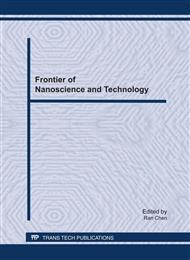p.309
p.315
p.319
p.324
p.328
p.332
p.337
p.341
p.345
Prepared and Magnetic Properties of B4C/C Coated Co Nanocapsules
Abstract:
B4C/C coated Co nanocapsules were prepared by arc-discharging a Co-B amorphous alloy. The structure, morphology and surface composition as well as magnetic properties were investigated by X-Ray diffraction, High Resolution Transmission Electron Microscopy and XPS photoelectron spectrum as well as Vibrating Sample Magnetometer, respectively. The results show the as-prepared nanoparticles form in a core¬¬¬-shell structure with the size of nanoparticles in range of 20-100nm, the thickness of the shell is about 3-10nm. The core is Co grains, while the shell is B4C/C compound. That B4C coated Co nanoparticles form in a core¬¬¬-shell structure ascribed to Co as catalysts accelerating reaction between B with C ionize in the arc-discharge course. This structure can prevent Co nanoparticles from oxidation and agglomeration. A saturation magnetization of Ms=75.6 Am2/kg and a coercive force of Hc=20.1 kA/m are achieved for as-prepared nanocapsules by VSM. For as–prepared nanocapsules, the saturation magnetization is reduced and coercive force of is enhanced while Comparing with Co block. The increase coercive force for as-prepared nanoparticles can be mainly ascribed to size of particles diminished and the domain-wall depinned in the multi-domain particles.
Info:
Periodical:
Pages:
328-331
Citation:
Online since:
July 2011
Authors:
Keywords:
Price:
Сopyright:
© 2011 Trans Tech Publications Ltd. All Rights Reserved
Share:
Citation:


